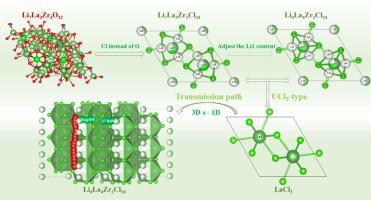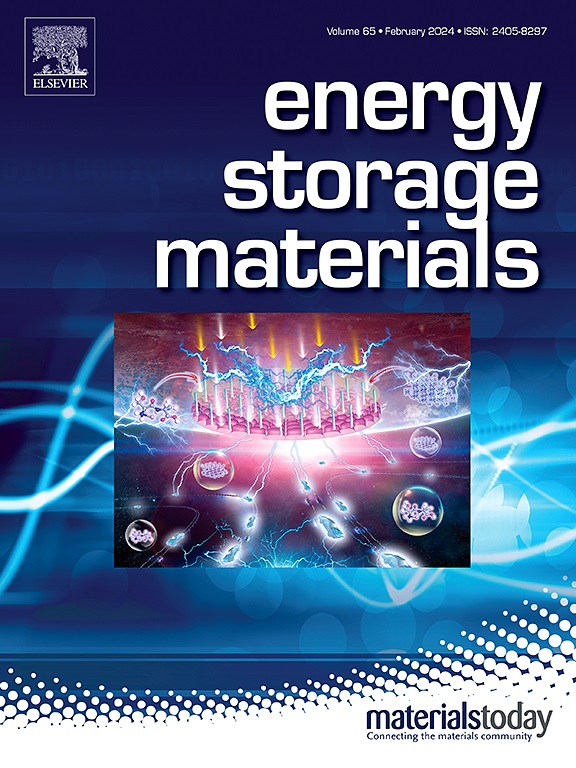From Li7La3Zr2O12 to Li4La4Zr2Cl24: Rapid three-dimensional transport of ions in halide solid electrolytes
IF 20.2
1区 材料科学
Q1 CHEMISTRY, PHYSICAL
引用次数: 0
Abstract
Inorganic solid electrolyte materials have emerged as a central focus in battery research, with halide solid electrolytes particularly favored due to their exceptional overall performance. However, the current preparation methods for halides often require extended time, and most raw materials, with the exception of Li2ZrCl6, tend to be costly. In this context, we focused on the oxide Li7La3Zr2O12 and successfully synthesized Li7La3Zr2Cl24 by substituting all O with Cl. Taking advantage of the unique properties of the LaCl3 lattice, we adjusted the ratios of La and Zr, and finally reported a novel halide, Li4La4Zr2Cl24, which exhibits a balanced Li and vacancies, as well as a three-dimensional interconnecting network for Li+ conduction. It is important that the synthesis process for this new material is relatively straightforward, requiring only 8 h of ball milling to achieve optimal ionic conductivity of 0.21 mS cm−1. This method has the potential to lower production costs and facilitate the development of halide series materials. At a current density of 1 C, the capacity retention rate of the all-solid-state battery assembled from this material is 73.66 % after 200 cycles. Additionally, the battery demonstrates stable cycling performance within a high voltage range of 2.2 to 4.5 V.


从Li7La3Zr2O12到Li4La4Zr2Cl24:卤化物固体电解质中离子的快速三维输运
无机固体电解质材料已成为电池研究的焦点,其中卤化物固体电解质因其优异的综合性能而受到青睐。然而,目前卤化物的制备方法往往需要较长的时间,而且除了Li2ZrCl6之外,大多数原材料往往价格昂贵。在此背景下,我们重点研究了氧化物Li7La3Zr2O12,并通过用Cl取代所有O成功合成了Li7La3Zr2Cl24。利用LaCl3晶格的独特性质,我们调整了La和Zr的比例,最终报道了一种新型卤化物Li4La4Zr2Cl24,它具有平衡的Li和空位,以及Li+传导的三维互连网络。重要的是,这种新材料的合成过程相对简单,只需要8小时的球磨就能达到0.21 mS cm−1的最佳离子电导率。该方法具有降低生产成本和促进卤化物系列材料发展的潜力。在电流密度为1℃时,该材料组装的全固态电池循环200次后容量保持率为73.66%。此外,该电池在2.2至4.5 V的高电压范围内具有稳定的循环性能。
本文章由计算机程序翻译,如有差异,请以英文原文为准。
求助全文
约1分钟内获得全文
求助全文
来源期刊

Energy Storage Materials
Materials Science-General Materials Science
CiteScore
33.00
自引率
5.90%
发文量
652
审稿时长
27 days
期刊介绍:
Energy Storage Materials is a global interdisciplinary journal dedicated to sharing scientific and technological advancements in materials and devices for advanced energy storage and related energy conversion, such as in metal-O2 batteries. The journal features comprehensive research articles, including full papers and short communications, as well as authoritative feature articles and reviews by leading experts in the field.
Energy Storage Materials covers a wide range of topics, including the synthesis, fabrication, structure, properties, performance, and technological applications of energy storage materials. Additionally, the journal explores strategies, policies, and developments in the field of energy storage materials and devices for sustainable energy.
Published papers are selected based on their scientific and technological significance, their ability to provide valuable new knowledge, and their relevance to the international research community.
 求助内容:
求助内容: 应助结果提醒方式:
应助结果提醒方式:


